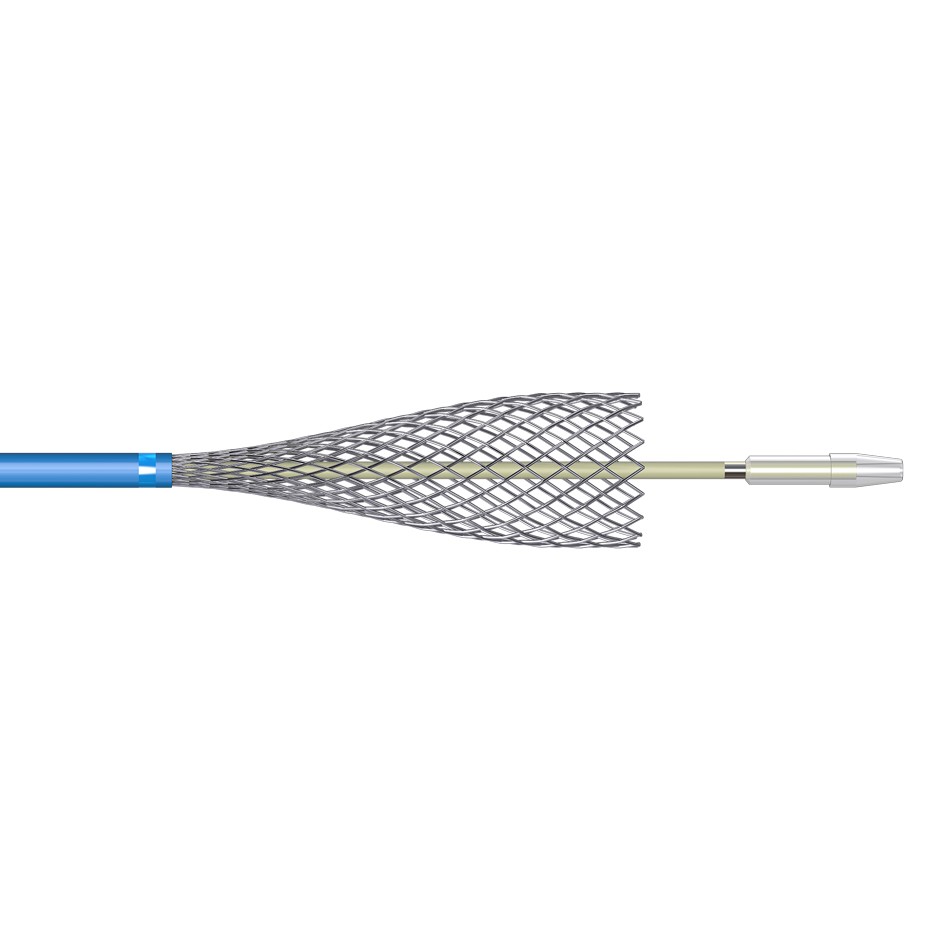CONTRAINDICATIONS
The Carotid WALLSTENT Endoprosthesis is contraindicated for use in:
- Patients in whom anticoagulant and/or antiplatelet therapy is contraindicated
- Patients with severe vascular tortuosity or anatomy that would preclude the safe introduction of a guide catheter, sheath, embolic protection system or stent system
- Patients with uncorrected bleeding disorders
- Lesions in the ostium of the common carotid artery
WARNINGS
- Refer to the Directions for Use supplied with any interventional devices to be used in conjunction with the Carotid WALLSTENT Endoprosthesis for their intended uses, contraindications, and potential complications.
- The safety and efficacy of the Carotid WALLSTENT Endoprosthesis have not been demonstrated with embolic protection devices other than the FilterWire EZ™ System.
- Risk of distal embolization may be higher if the Carotid WALLSTENT Endoprosthesis cannot be used in conjunction with an embolic protection system during the carotid stenting procedure.
- The long-term performance of the Carotid WALLSTENT Endoprosthesis has not been established.
- Stenting across a major bifurcation may hinder or prevent future diagnostic or therapeutic procedures.
- In patients requiring the use of antacids and/or H2-antagonists before or immediately after stent placement, oral absorption of antiplatelet agents such as aspirin may be adversely affected.
- The implantation of the Carotid WALLSTENT Endoprosthesis should be performed only under fluoroscopic observation with radiographic equipment providing high-resolution images.
- Never advance the Carotid WALLSTENT Endoprosthesis without the guidewire extending from the tip.
- Do not advance the Carotid WALLSTENT Endoprosthesis against significant resistance.
- The Carotid WALLSTENT Endoprosthesis should be oversized in relation to the artery diameter by 1 mm to 2 mm to prevent migration.
- Do not release the Carotid WALLSTENT Endoprosthesis if unusual force is required; in such a situation use another device.
- Never advance a partially deployed Carotid WALLSTENT Endoprosthesis distally.
- Reconstrainment and repositioning of the Carotid WALLSTENT Endoprosthesis should be strictly avoided when the partially deployed Carotid WALLSTENT Endoprosthesis is already in contact with the plaque of the stenosis.
- Use of this device in patients with hypersensitivity to cobalt, chromium, iron, nickel, or molybdenum may provoke an allergic reaction.
- Avoid using power injection in the cerebral circulation.
Device Use
- Implanting a stent may lead to dissection of the vessel distal and/or proximal to the stent and may cause acute closure of the vessel, requiring additional intervention (carotid endarterectomy, further dilatation, or placement of additional stents).
- The stent may cause a thrombus, distal embolization or may migrate from the site of implant down the arterial lumen. Appropriate sizing of the stent to the vessel is required to reduce the possibility of stent migration. In the event of thrombosis of the expanded stent, thrombolysis and PTA should be attempted.
- In the event of complications such as infection, pseudoaneurysm or fistulization, surgical removal of the stent may be required.
- Overstretching of the artery may result in rupture and lifethreatening bleeding.
- Balloon angioplasty of the carotid bifurcation may initiate transient hemodynamic instability consisting of bradycardia or hypotension. Appropriate pharmacologic therapy must be immediately available.
PRECAUTIONS
Stent Handling
- Do not hold the sheath or stent during stylus removal.
Stent Placement
- The Carotid WALLSTENT Endoprosthesis is not compatible with any guidewire larger than 0.014 in (0.36 mm).
- The Carotid WALLSTENT Endoprosthesis must be used with a guiding catheter or guiding sheath to maintain adequate support of the 0.014 in (0.36 mm) guidewire throughout the procedure.
- For best device performance, the guidewire exit notch should remain within the guiding catheter or guiding sheath.
- Ensure the stent system is fully flushed with heparinized saline prior to use. Do not use the delivery system if flush is not observed exiting at the distal end of the sheath.
Magnetic Resonance Imaging (MRI) Compatibility
Through non-clinical testing, the Carotid WALLSTENT MonorailR Endoprosthesis (Carotid WALLSTENT Endoprosthesis), has been shown to be MRI safe at field strengths of 3.0 Tesla or less, and a maximum whole body averaged specific absorption rate (SAR) of 2.0 W/kg for15 minutes of MRI exposure. The Carotid WALLSTENT Endoprosthesis should not migrate in this MRI environment. Non-clinical testing has not been performed to rule out the possibility of stent migration at field strengths higher than 3.0 Tesla. MRI at 3.0 Tesla or less may be performed immediately following the implantation of the Carotid WALLSTENT Endoprosthesis. MR image quality may be compromised if the area of interest is in the exact same area or relatively close to the position of the stent. MR image artifact has been evaluated at 1.5 Tesla only.

